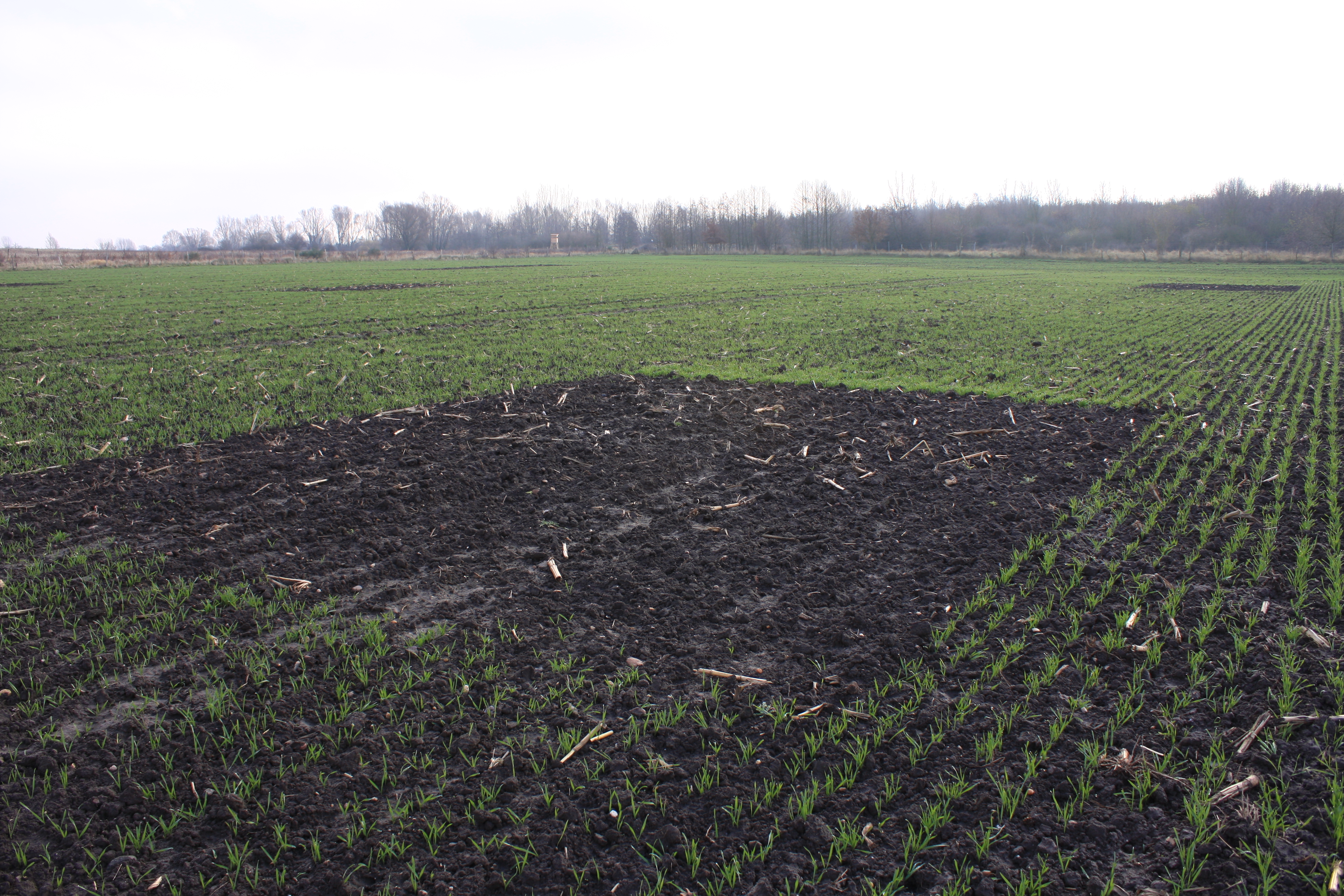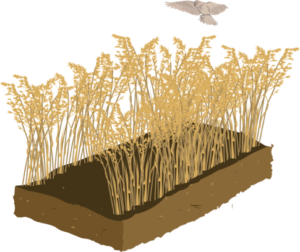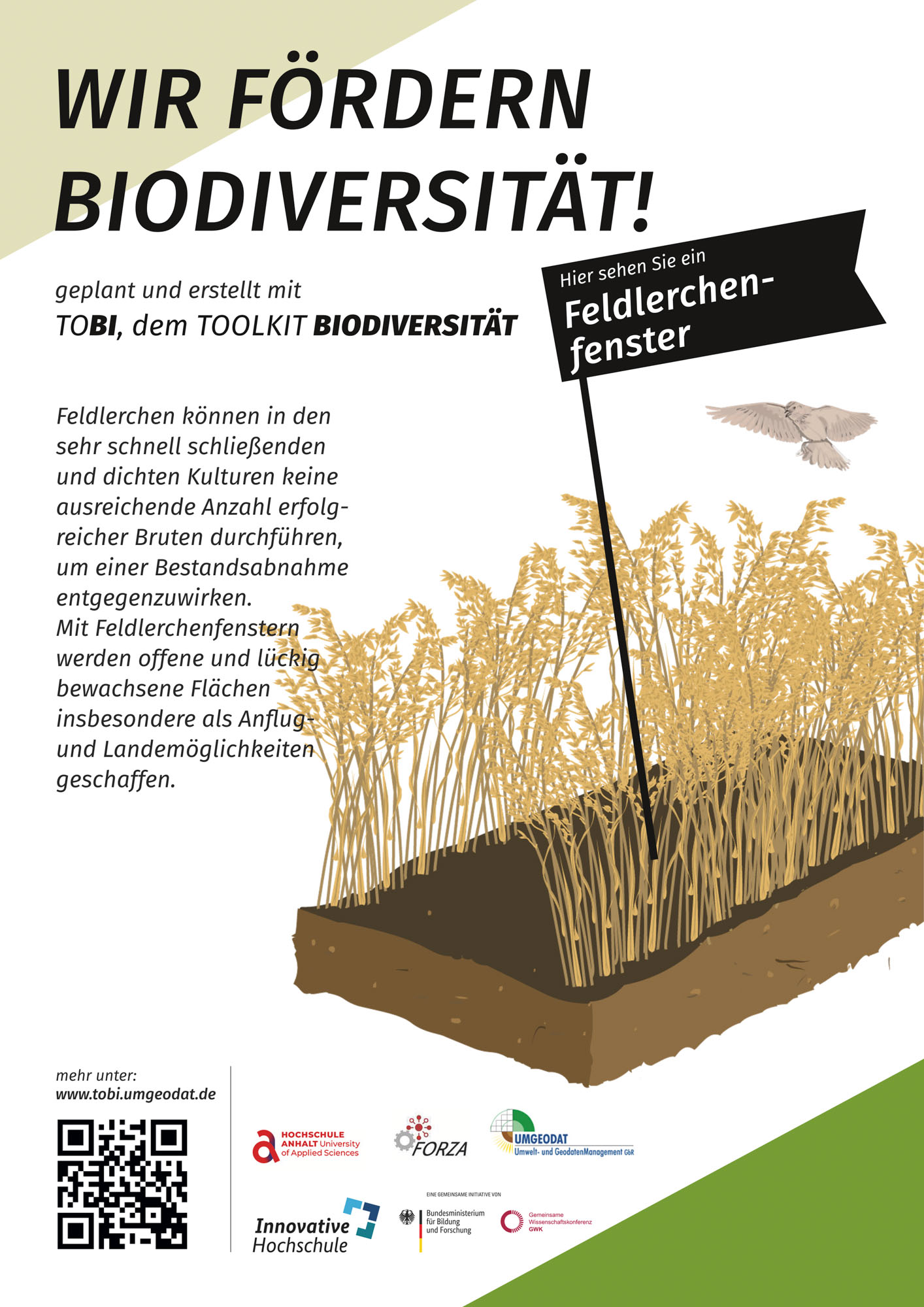Erfahren Sie alles über Feldlerchen-Fenster
Sind Sie sicher ob der Standort geeignet ist?
Das Profitool erkennt Flächen und kann die optimale Nutzung bestimmen. PROFITOOL
Feldrandschild
Mit dem Feldrandschild teilen Sie der Umgebung mit, welche biodiversitätsfördernden Maßnahmen Sie umgesetzt haben.
Do you need support?
Then please contact us by phone 039209 / 202076 or by e-mail at info@stiftung-kulturlandschaft-sachsen-anhalt.de.
Requirements
Window sizes and numbers:
- at least 20 square metres (at least 3 m wide and corresponding length); in tall crops such as maize or rapeseed, create larger windows
- Recommendation 2-10 windows/ha
Site and soil conditions:
- dry to wet
- in all cereal, rapeseed and maize crops (except green rye and winter barley)
Costs:
Harvest losses approx. 2.5-4 € (max. 5 €) per window
Machinery requirements:
No special requirements necessary
Implementation period:
at the same time as the field is cultivated
Implementation
step-by-step instruction
1. Site selection
Suitable in areas with
- with skylark occurrences or with neighbouring occurrences
- Low crop diversity on fields from 5 ha in size
- in all fast and tightly closing crops: cereals (except green rye and winter barley), rapeseed and maize

Implementation
- create at least 2 and up to 10 windows per hectare with a minimum size of 20 m² (minimum width 3 m)
- create larger windows in tall crops such as maize or rapeseed
- Two possibilities of realisation:
- Raising / lowering the seed drill during sowing
- subsequent milling or tilling of the window surfaces
Note:
- Minimum distance of 50 m to other structures such as copses, hedges, flowering areas, paths
- Keep the greatest possible distance from machine tracks to reduce predator pressure
- When planting new woody structures, ensure that the minimum distance to the windows is still maintained!

Care
step-by-step instruction
Management
- Further management of the windows is the same as for the surrounding crop
- Keep the greatest possible distance from machine tracks to reduce predator pressure
- In the case of mechanical and chemical plant protection measures, if possible, cut out the windows including a buffer area around them


Ecological impact
Many species of farmland birds, such as the skylark, have seen their populations plummet in recent decades. Skylarks prefer open and sparsely vegetated areas for nesting and foraging. Especially in winter crops, such as winter cereals and rapeseed, which close quickly and grow densely during the vegetation period, skylarks have difficulties penetrating the vegetation and breeding successfully.
Mit Feldlerchen-Fenstern werden offene und lückig bewachsene Flächen insbesondere als Anflug- und Landemöglichkeiten geschaffen, sodass zum Teil auch eine zweite Brut ermöglicht wird. Die Fenster sind insbesondere als ergänzende Maßnahmen geeignet. Wichtig ist weiterhin die Schaffung von Nahrungshabitaten durch die Kombination der Maßnahme mit z. B. mehrjährigen Blühstreifen, Säumen, Ackerrandstreifen oder Schonstreifen in der näheren Umgebung von 100 bis max. 300 m, da Feldlerchen zur Futtersuche nur sehr geringe Entfernungen zurücklegen.
Additional information (mostly in German)
As an alternative to skylark windows, large field structures and dense crops can be broken up with additional machine tracks or so-called arable bird strips.
Additional machine tracks should also be created at least 50 m away from forest edges and at a distance of approx. 9 to 12 m from each other. To reduce predation pressure and prevent accidental traffic, it helps to have the additional machine tracks end blindly in the stand.
Arable bird strips can be planned, for example, as summer cereal or fallow strips. If the strips are at least 10 metres wide and are laid out with the main wind direction in mind, they can also serve as hunting corridors to regulate high local densities of wild boar. The strips should be created in close consultation with the regional authorised hunters.
- Merkblatt Feldlerchenfenster (Hochschule Anhalt 2021)
- Projektbericht „ 1000 Äcker für die Feldlerche “ (Cimiotti et al. 2011)
- Hoffnung im Getreidefeld: Feldlerchenfenster (Morris 2009)
- Untersuchungen zur Wirkung von „Feldlerchenfenstern“ in Winterweizen (Fehnle 2013)
- PIK – Produktionsintegrierte Kompensationsmaßnahmen in Sachsen-Anhalt (Stiftung Kulturlandschaft Sachsen-Anhalt 2021)
- Arbeitshilfe Produktionsintegrierte Kompensation (Etterer et al. 2020)
- Zur Ernährungsökologie der Feldlerche in der Reproduktionsphase (Jeromin 2002)
- Suitability of patches and in-field strips for Sky Larks Alauda arvensis in a small-parcelled mixed farming area (Fischer et al. 2009)
- Vogelschutz auf Ackerland – Praxishandbuch für Landwirte (Vogelschutzwarte Neschwitz 2014)
- Feldlerchenstreifen (FRANZ-Projekt)
- Bejagungsschneisen in der Agrarlandschaft – Anlage und Bewirtschaftung (Landesjagdverband Sachsen-Anhalt 2020)








